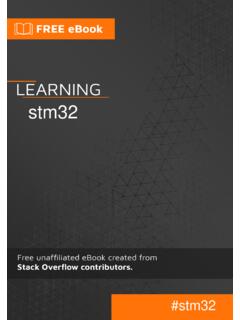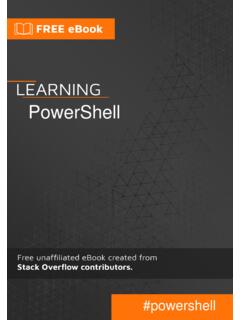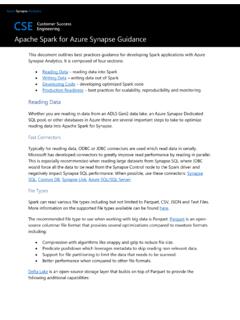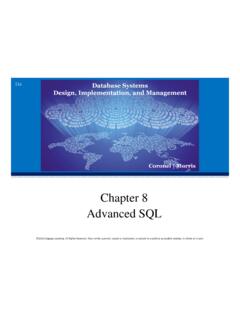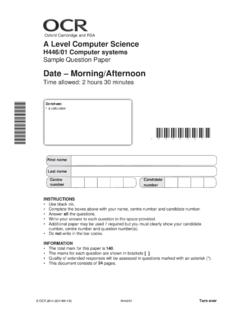Transcription of excel-vba
1 excel-vba # excel-vba Table of Contents About 1. Chapter 1: Getting started with excel-vba 2. Remarks 2. Versions 2. VB 2. Excel 3. Examples 3. Declaring Variables 3. Other ways of declaring variables are: 4. Opening the Visual Basic Editor (VBE) 5. Adding a new Object Library Reference 6. Hello World 11. Getting Started with the Excel Object Model 13. Chapter 2: Application object 17. Remarks 17. Examples 17. Simple Application Object example: Minimize the Excel window 17. Simple Application Object example: Display Excel and VBE Version 17. Chapter 3: Arrays 18. Examples 18. Populating arrays (adding values) 18. Directly 18. Using Array() function 18. From range 18. 2D with Evaluate() 19. Using Split() function 19. Dynamic Arrays (Array Resizing and Dynamic Handling) 19. Jagged Arrays (Arrays of Arrays) 19. Check if Array is Initialized (If it contains elements or not).
2 20. Dynamic Arrays [Array Declaration, Resizing] 20. Chapter 4: autofilter ; Uses and best practices 21. Introduction 21. Remarks 21. Examples 21. Smartfilter! 21. Chapter 5: Binding 27. Examples 27. Early Binding vs Late Binding 27. Chapter 6: Charts and Charting 29. Examples 29. Creating a Chart with Ranges and a Fixed Name 29. Creating an empty Chart 30. Create a Chart by Modifying the SERIES formula 32. Arranging Charts into a Grid 34. Chapter 7: Common Mistakes 38. Examples 38. Qualifying References 38. Deleting rows or columns in a loop 39. ActiveWorkbook vs. ThisWorkbook 39. Single Document Interface Versus Multiple Document Interfaces 40. Chapter 8: Conditional formatting using VBA 43. Remarks 43. Examples 43. 43. Syntax: 43. Parameters: 43. XlFormatConditionType enumaration: 43. Formatting by cell value: 44. Operators: 44. Formatting by text contains: 45.
3 Operators: 45. Formatting by time period 45. Operators: 45. Remove conditional format 46. Remove all conditional format in range: 46. Remove all conditional format in worksheet: 46. 46. Highlighting Duplicate Values 46. Highlighting Unique Values 46. 46. Highlighting Top 5 Values 46. 47. Operators: 47. 47. IconSet: 48. Type: 49. Operator: 50. Value: 50. Chapter 9: Conditional statements 51. Examples 51. The If statement 51. Chapter 10: Creating a drop-down menu in the Active Worksheet with a Combo Box 53. Introduction 53. Examples 53. Jimi Hendrix Menu 53. Example 2: Options Not Included 54. Chapter 11: CustomDocumentProperties in practice 57. Introduction 57. Examples 57. Organizing new invoice numbers 57. Chapter 12: Debugging and Troubleshooting 60. Syntax 60. Examples 60. 60. Stop 60. Immediate Window 60. Use Timer to Find Bottlenecks in Performance 61.
4 Adding a Breakpoint to your code 62. Debugger Locals Window 62. Chapter 13: Excel VBA Tips and Tricks 65. Remarks 65. Examples 65. Using xlVeryHidden Sheets 65. Worksheet .Name, .Index or .CodeName 66. Using Strings with Delimiters in Place of Dynamic Arrays 68. Double Click Event for Excel Shapes 69. Open File Dialog - Multiple Files 69. Chapter 14: excel-vba Optimization 71. Introduction 71. Remarks 71. Examples 71. Disabling Worksheet Updating 71. Checking time of execution 71. Using With blocks 72. Row Deletion - Performance 73. Disabling All Excel Functionality Before executing large macros 74. Optimizing Error Search by Extended Debugging 75. Chapter 15: File System Object 78. Examples 78. File, folder, drive exists 78. File exists: 78. Folder exists: 78. Drive exists: 78. Basic file operations 78. Copy: 78. Move: 79. Delete: 79. Basic folder operations 79.
5 Create: 79. Copy: 79. Move: 79. Delete: 80. Other operations 80. Get file name: 80. Get base name: 80. Get extension name: 80. Get drive name: 81. Chapter 16: How to record a Macro 82. Examples 82. How to record a Macro 82. Chapter 17: Locating duplicate values in a range 85. Introduction 85. Examples 85. Find duplicates in a range 85. Chapter 18: Loop through all Sheets in Active Workbook 87. Examples 87. Retrieve all Worksheets Names in Active Workbook 87. Loop Through all Sheets in all Files in a Folder 87. Chapter 19: Merged Cells / Ranges 89. Examples 89. Think twice before using Merged Cells/Ranges 89. Where is the data in a Merged Range? 89. Chapter 20: Methods for Finding the Last Used Row or Column in a Worksheet 90. Remarks 90. Examples 90. Find the Last Non-Empty Cell in a Column 90. Find Last Row Using Named Range 91. Get the row of the last cell in a range 91.
6 Find the Last Non-Empty Column in Worksheet 92. Last cell in 92. Find the Last Non-Empty Row in Worksheet 93. Find the Last Non-Empty Cell in a Row 93. Find the Last Non-Empty Cell in Worksheet - Performance (Array) 94. Chapter 21: Named Ranges 96. Introduction 96. Examples 96. Define A Named Range 96. Using Named Ranges in VBA 96. Manage Named Range(s) using Name Manager 97. Named Range Arrays 99. Chapter 22: Pivot Tables 101. Remarks 101. Examples 101. Creating a Pivot Table 101. Pivot Table Ranges 103. Adding Fields to a Pivot Table 103. Formatting the Pivot Table Data 103. Chapter 23: PowerPoint Integration Through VBA 105. Remarks 105. Examples 105. The Basics: Launching PowerPoint from VBA 105. Chapter 24: Ranges and Cells 107. Syntax 107. Remarks 107. Examples 107. Creating a Range 107. Ways to refer to a single cell 109. Saving a reference to a cell in a variable 109.
7 Offset Property 110. How to Transpose Ranges (Horizontal to Vertical & vice versa) 110. Chapter 25: SQL in Excel VBA - Best Practices 111. Examples 111. How to use in VBA? 111. Requirements: 111. Declare variables 111. Create connection 111. a. with Windows Authentication 112. b. with SQL server Authentication 112. execute sql command 112. Read data from record set 112. Close connection 112. How to use it? 112. Result 113. Chapter 26: Use Worksheet object and not Sheet object 114. Introduction 114. Examples 114. Print the name of the first object 114. Chapter 27: User Defined Functions (UDFs) 115. Syntax 115. Remarks 115. Examples 115. UDF - Hello World 115. Allow full column references without penalty 117. Count Unique values in Range 118. Chapter 28: VBA Best Practices 119. Remarks 119. Examples 119. ALWAYS Use "Option Explicit" 119. Work with Arrays, Not With Ranges 121.
8 Use VB constants when available 122. Use descriptive variable naming 123. Error Handling 124. On Error GoTo 0 124. On Error Resume Next 124. On Error GoTo <line> 125. Document Your Work 126. Switch off properties during macro execution 127. Avoid using ActiveCell or ActiveSheet in Excel 129. Never Assume The Worksheet 129. Avoid using SELECT or ACTIVATE 130. Always define and set references to all Workbooks and Sheets 131. WorksheetFunction object executes faster than a UDF equivalent 132. Avoid re-purposing the names of Properties or Methods as your variables 133. Chapter 29: VBA Security 135. Examples 135. Password Protect your VBA 135. Chapter 30: Workbooks 136. Examples 136. Application Workbooks 136. When To Use ActiveWorkbook and ThisWorkbook 136. Opening A (New) Workbook, Even If It's Already Open 137. Saving A Workbook Without Asking The User 138.
9 Changing The Default Number of Worksheets In A New Workbook 138. Chapter 31: Working with Excel Tables in VBA 139. Introduction 139. Examples 139. Instantiating a ListObject 139. Working with ListRows / ListColumns 139. Converting an Excel Table to a normal range 140. Credits 141. About You can share this PDF with anyone you feel could benefit from it, downloaded the latest version from: excel-vba It is an unofficial and free excel-vba ebook created for educational purposes. All the content is extracted from Stack Overflow Documentation, which is written by many hardworking individuals at Stack Overflow. It is neither affiliated with Stack Overflow nor official excel-vba . The content is released under Creative Commons BY-SA, and the list of contributors to each chapter are provided in the credits section at the end of this book. Images may be copyright of their respective owners unless otherwise specified.
10 All trademarks and registered trademarks are the property of their respective company owners. Use the content presented in this book at your own risk; it is not guaranteed to be correct nor accurate, please send your feedback and corrections to 1. Chapter 1: Getting started with excel-vba Remarks Microsoft Excel includes a comprehensive macro programming language called VBA. This programming language provides you with at least three additional resources: 1. Automatically drive Excel from code using Macros. For the most part, anything that the user can do by manipulating Excel from the user interface can be done by writing code in Excel VBA. 2. Create new, custom worksheet functions. 3. Interact Excel with other applications such as Microsoft Word, PowerPoint, Internet Explorer, Notepad, etc. VBA stands for Visual Basic for Applications. It is a custom version of the venerable Visual Basic programming language that has powered Microsoft Excel's macros since the mid-1990s.
